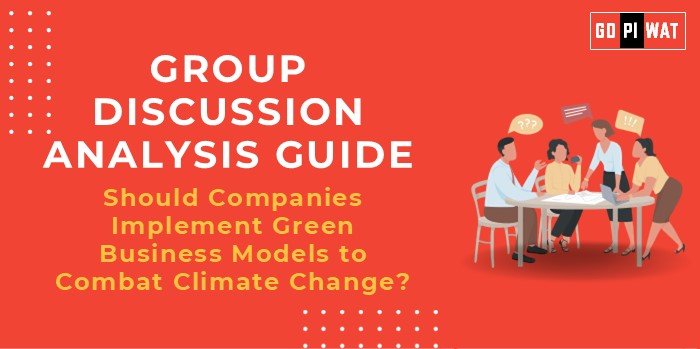📋 Group Discussion Analysis Guide: Should Companies Implement Green Business Models to Combat Climate Change?
🌐 Introduction to Green Business Models and Climate Change
Opening Context: “As climate change becomes a critical global challenge, businesses face increasing pressure to adopt green models that prioritize sustainability. Such strategies focus on reducing carbon emissions, integrating renewable energy, and promoting circular economies.”
Topic Background: “The momentum for green business practices grew with global agreements like the Kyoto Protocol (1997) and Paris Agreement (2015). Today, stakeholder demand for sustainability drives companies to align profitability with environmental responsibility.”
📊 Quick Facts and Key Statistics
• 💰 Green Investments: $2.5 trillion in sustainable funds globally (2023).
• 📈 Business Impact: 20% higher operational efficiency and 15% boost in brand trust with sustainability initiatives.
• 🛍️ Consumer Sentiment: 70% of millennials prefer eco-conscious brands.
• 🏛️ Legislation Trends: EU Green Deal and India’s EPR mandate sustainable business practices.
🤝 Stakeholders and Their Roles
- 🏛️ Governments: Enforce climate policies, provide incentives, and set emission caps.
- 🏢 Businesses: Innovate sustainable products, reduce carbon footprints, and adopt renewable energy.
- 🛍️ Consumers: Drive demand for green products, influencing corporate sustainability strategies.
- 💵 Investors: Back ESG-compliant companies to promote sustainable economic growth.
- 🌱 Global Organizations: Framework providers like UNFCC and IPCC advocate for sustainable development.
🏆 Achievements and Challenges
✨ Achievements:
- 💼 Profitability and Efficiency: Tesla and Unilever report financial gains with sustainability integration.
- 🌱 Environmental Benefits: Renewable energy adoption reduces CO₂ emissions by 25% on average.
- 📈 Competitive Edge: Apple and Google lead with carbon-neutral operations.
- 🔄 Innovation: Startups focusing on circular economies revolutionize supply chains.
⚠️ Challenges:
- 💰 High Initial Costs: Transitioning to green practices requires significant capital investment.
- 🌍 Regulatory Inconsistencies: Varying environmental laws complicate compliance for multinationals.
- 📉 Short-Term Profit Pressures: Prioritizing immediate financial goals over long-term sustainability.
🌎 Global Comparisons:
- 🇩🇰 Denmark: Over 50% of electricity comes from wind power.
- 🇩🇪 Germany: Companies like Siemens integrate green practices for environmental and economic success.
📚 Case Studies:
- 🏭 Aditya Birla Group: Reduced emissions by 20% with waste-to-energy systems.
- 🌟 Patagonia: Built a strong brand by prioritizing sustainable materials and circular production.
🗣️ Structured Arguments for Discussion
Supporting Stance: “Green business models combat climate change, enhance profitability, and build brand trust while improving operational efficiency.”
Opposing Stance: “The high costs of adopting green practices and uncertain returns pose significant challenges, especially for SMEs.”
Balanced Perspective: “While challenging initially, green business models are essential for long-term sustainability, benefiting all stakeholders.”
💡 Effective Discussion Approaches
- 📜 Opening Approaches:
- “Industries contribute nearly 30% of global emissions, underscoring the urgency for green business adoption.”
- “While Tesla thrives on sustainable practices, many SMEs struggle to balance green goals with profitability.”
- 🛠️ Counter-Argument Handling:
- “Although initial costs are high, long-term savings and efficiency gains outweigh investments.”
- “Government subsidies can alleviate financial strain on small businesses transitioning to green models.”
📈 Strategic Analysis of Strengths and Weaknesses
- 🏅 Strengths: Enhanced reputation, operational savings, long-term profitability.
- ⚠️ Weaknesses: High upfront costs, reliance on advanced technology.
- 💡 Opportunities: Innovation in clean tech, public-private partnerships, rising demand for sustainable products.
- ⚡ Threats: Regulatory hurdles, greenwashing risks, global competition.
🎓 Connecting with B-School Applications
- 📚 Real-World Applications: Projects on sustainability frameworks, ESG implementation, and clean energy solutions.
- 💬 Sample Interview Questions:
- “How do green business models impact profitability?”
- “What strategies can SMEs use to transition to sustainable practices?”
- 🔑 Insights for B-School Students: Focus on integrating sustainability with profitability, understanding stakeholder collaboration, and exploring innovative green solutions.


